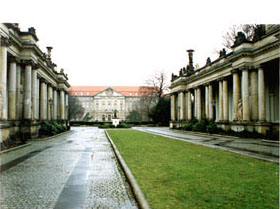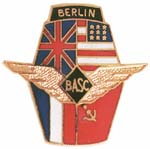 Following the unsuccessful bomb plot against Hitler, carried out by Claus
von Stauffenberg, the court was used as the location of a number of show
trials of which the most notable was that of Field Marshall Erwin von Witzleben.
Von Witzleben was the most senior of the bomb plot perpetrators left alive
following the summary execution the principal perpetrators of von Stauffenberg,
von Quirnheim, Olbricht and von Haeften in the court yard of the Army High
Command Headquarters in the nearby Bendlerstraße. (Renamed Stauffenbergerstraße).
Following the allied bombing of Berlin, with over 200 rooms, the building
was one of very few suitable for accommodation in 1945 and was requisitioned
by the Allies for the administration of the whole of occupied Germany.
Indeed, the establishment of the BASC and the Air Corridors
was one of very few working agreements made between the Soviets and
the Allies prior to the complete breakdown of relations between the two
sides and the subsequent outbreak of The Cold War. Using only a handful
of rooms, the BASC thus found itself the only occupant of a building intended
for much wider use and during its entire history, much of the building
remained on a care and maintenance basis.
Following the unsuccessful bomb plot against Hitler, carried out by Claus
von Stauffenberg, the court was used as the location of a number of show
trials of which the most notable was that of Field Marshall Erwin von Witzleben.
Von Witzleben was the most senior of the bomb plot perpetrators left alive
following the summary execution the principal perpetrators of von Stauffenberg,
von Quirnheim, Olbricht and von Haeften in the court yard of the Army High
Command Headquarters in the nearby Bendlerstraße. (Renamed Stauffenbergerstraße).
Following the allied bombing of Berlin, with over 200 rooms, the building
was one of very few suitable for accommodation in 1945 and was requisitioned
by the Allies for the administration of the whole of occupied Germany.
Indeed, the establishment of the BASC and the Air Corridors
was one of very few working agreements made between the Soviets and
the Allies prior to the complete breakdown of relations between the two
sides and the subsequent outbreak of The Cold War. Using only a handful
of rooms, the BASC thus found itself the only occupant of a building intended
for much wider use and during its entire history, much of the building
remained on a care and maintenance basis.

Frozen in a time warp, by 1980 the equipment used in the BASC was distinctly dated. As is mentioned under Tempelhof, British Airways and Pan American had moved to Tegel in 1975. Amidst the equipment in a modern operations room, was a black World War 2 phone, communications between BASC and the company. The BASC control room, itself situated in one wing, was a modest, wood panelled room where military officers of the Four Powers worked. In general the atmosphere was extremely informal since by the nature of the job, all the occupants knew each other fairly well. Only on rare occasions did matters resolve themselves to the formality described in "Hole in the Berlin Wall".
It is interesting to note that BASC used to host social events in the court room used for the von Witzleben trials which, over the main entrance, had been maintained as part of the working part of the building. Guests and visitors would be shown a hole in the door made for a camera used to photograph the trial and these photos of the period were retained to demonstrate the result -The hapless von Witzleben had been deliberately dressed in trousers many times his size in order that he be made look ridiculous as he was forced to hold them up for the duration of the hearing. In fact, by all accounts, he maintained his dignity throughout and acquitted himself well during the proceedings. Inevitably, however, he was hanged in Plötzenzee Prison in 1944, another victim of the NAZI regime
Perhaps even more sinister, in another part of the building, was a large bracket arrangement at the rear of one of the smaller courts. Although no there was no direct evidence as to its purpose, it seems likely that, during the same period, justice was summarily carried out following a trial as little, other than use as a gibbet, could be determined for such an arrangement.
Mailto Chris@bejaflor.plus.com